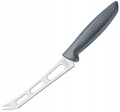Blade length
The length of a blade is usually measured from the point to the neck (the bulge between the blade and the handle). The value of this parameter is determined primarily by the type of knife. For example, in
models for cleaning, it rarely exceeds 12 cm — otherwise it would be inconvenient to work with small round products). Among
bread, on the contrary, blades shorter than 20 cm are rarely found — loaves of bread can be quite thick, which requires an appropriate knife, etc. However, knives of the same type can also vary significantly in length. In most cases, you can use this principle: a longer knife allows you to work with larger pieces of food, but it is less “agile”, and the length of the blade can affect the price.
Hardness
The hardness of the metal used in the knife blade. Indicated in standard HRC units (according to Rockwell); the higher the value, the harder the blade.
This parameter in knives has a double meaning. On the one hand, the blade must be hard enough so as not to dull prematurely, not form burrs and not deform when bent; on the other hand, it must remain soft in order to sharpen normally, not crack or break (brittleness also increases with increasing hardness). In most kitchen knives, the hardness is in the range of 52 - 62 HRC - it is believed that this range provides the optimal ratio of strength, reliability and ease of sharpening.
In general, ceteris paribus, a knife made of softer steel will have to be sharpened or adjusted more often with musat, however, such procedures themselves will take a little time and effort. Conversely, a hard blade will hold sharpening for a long time, however, you will have to try to restore it.
Serrated blade
The presence of teeth on the cutting edge except for the knife — the so-called serrated (or semi-serrated, if the teeth do not occupy the entire cutting edge) sharpening. One of the main advantages of serrated edges over smooth ones is the ability to cut even after the knife becomes noticeably dull — the very shape of the teeth allows you to “bite” into the product due to back and forth movements. In addition,
serrated knives are indispensable for delicate products, especially those with a crust, such as fresh bread or soft vegetables (which is why specialized models for bread and
tomatoes are most often referred to as serrated knives). On the other hand, sharpening a blunt serrator is a serious problem. In the best case — if the teeth are large — for this you will have to use a special tool that sharpens each tooth separately; if the teeth are small, then the only option is to completely resharpen the blade, turning it into an ordinary smooth one. In addition, serrated sharpening is less versatile, because. for some types of work it is not suitable in principle — therefore, it is worth buying such a knife only if the household already has one or more smooth ones.
